Tom's Hardware Verdict
The Be Quiet Dark Power Pro 13 is an exceptional PSU with outstanding efficiency, solid build quality, and quiet performance. While it boasts excellent features and reliability, its high price tag may be hard to justify for those seeking more cost-effective options. However, for enthusiasts demanding uncompromising performance and longevity, it is a worthy investment.
Pros
- +
80 Plus Titanium efficiency
- +
Quiet operation
- +
Premium build quality
- +
Amazing electrical performance
- +
Modular design & elegant aesthetics
- +
10-year warranty
Cons
- -
High price
- -
Large form factor
- -
No semi-passive cooling
Why you can trust Tom's Hardware
As ATX 3.0 power supplies have proliferated over the last couple of years, we've seen an interesting mix in design pedigrees for PSUs targeting the newer power standard. For some manufacturers this has meant bringing up entirely new PSU designs by OEMs new and old, developing fresh platforms to accommodate the new 12+4 pin PCI Express connector and its up to 600-watt power limits. Meanwhile, for other manufacturers, especially at the high end of the market, their existing PSU designs were so bulletproof that they have been able to add everything needed for ATX 3.0 compliance with only very modest changes. The ATX 3.1 design guide that was released a few months after brought few changes for PSU manufacturers, as it was less demanding towards PSUs than ATX 3.0, meaning that all ATX 3.0-compliant PSUs automatically are ATX 3.1 compliant as well (strictly speaking, PSU manufacturers technically need to have a PCIe 5.1 connector on the PSU’s side for full compliance).
For Be Quiet's flagship power supply lineup, the Dark Power Pro series, the company falls distinctly into the second group. The pride and joy of Be Quiet's lineup has always been the pinnacle of the company’s engineering abilities, with the best possible specifications their engineers could muster (and equally prodigious price tags for the consumer). Besides making for long-lived PSUs, that kind of engineering rigor has also allowed for a long-lived platform – even with the more extreme power delivery requirements brought about by ATX 3.0, Be Quiet has only needed to make a handful of changes to meet the new standard.
The result of those updates is the latest generation of the Dark Power Pro series, the Dark Power Pro 13, which we are looking at today. The 13th iteration of Be Quiet's lead PSU series builds upon their already impressive design for the Dark Power Pro 12, adding compliance with Intel’s ATX 3.0 design guide while retaining the 80 Plus Titanium certification and impressive features of the previous version. The series was released before the ATX 3.1 design guide was published and the company did not bother rebadging these units as ATX 3.1 compliant.
Specifications and Design
| RAIL | +3.3V | +5V | +12V | +5Vsb | -12V |
| MAX OUTPUT | 25A | 25A | 108.33A | 3.5A | 0.3A |
| Row 2 - Cell 0 | 130W | Row 2 - Cell 2 | 1300W | 17.5W | 3.6W |
| TOTAL | 1300W | Row 3 - Cell 2 | Row 3 - Cell 3 | Row 3 - Cell 4 | Row 3 - Cell 5 |
| AC INPUT | 100 - 240 VAC, 50 - 60 Hz | Row 4 - Cell 2 | Row 4 - Cell 3 | Row 4 - Cell 4 | Row 4 - Cell 5 |
| MSRP | $330 | Row 5 - Cell 2 | Row 5 - Cell 3 | Row 5 - Cell 4 | Row 5 - Cell 5 |
In the Box
We received the Dark Power Pro 13 in an aesthetically simple yet very luxurious cardboard box. The exterior surface of the box has been coated to mimic a velvet-like feel, with the designer keeping almost the entirety of the box plain. The box itself is very thick and has multiple layers, with additional high-density packaging foam protecting the PSU itself.

Inside the box, we found an AC power cable (IEC C19), four typical mounting screws and four thumbscrews for the user to select whichever they prefer, ten cable straps, a few cable ties, numerous wire combs, and a PCI slot switch. The IEC C19 cable was necessary for a PSU with that kind of power output as it can surpass the current capacity of common C13 connectors when the input voltage is 115V or below.

The PCI slot switch can be used to turn the “overclocking” mode on and off. When off, the PSU has multiple virtual 12V rails, monitoring them for overcurrent individually. When on, it monitors the entire 12V line as a single rail, preventing the PSU from shutting down when a single connector draws a little bit too much power. The catch is that the latter mode cannot discern single-wire critical faults, and such a fault could lead to a massive current over a single wire, irreversibly damaging it. So, there is a bit of a product safety trade-off for the improved overclocking flexibility.

The Dark Power Pro 13 is a fully modular design, allowing for the removal of every DC power cable, including the 24-pin ATX connector. Most of the cables are black, with black connectors and individually sleeved wires, with the sole exception being the two 12VHPWR cables which are typical black cables with one external nylon sleeve. It is also interesting to note that Be Quiet! entirely removed the practically obsolete floppy disk connectors, although the previous version of the Dark Power Pro series offered not one but two of them.
Get Tom's Hardware's best news and in-depth reviews, straight to your inbox.

| Connector type | Hardwired | Modular |
|---|---|---|
| ATX 24 Pin | - | 1 |
| EPS 4+4 Pin | - | 2 |
| EPS 8 Pin | - | - |
| PCI-E 5.0 | - | 2 |
| PCI-E 8 Pin | - | 6 |
| SATA | - | 16 |
| Molex | - | 5 |
| Floppy | - | - |
External Appearance
Much like its predecessor, the Dark Power Pro 13 series is built around a unique aluminum chassis with very smooth brushed surfaces and sharp edges. The body of the unit measures 200 mm deep, making it much longer than a standard ATX PSU. Although this should not be a problem with any large PC case, it could become a concern if the PSU is meant for a compact build.

The company and series logos are printed on one side of the unit in chrome lettering. A sticker with the unit’s electrical specifications and certifications covers most of the other side, with smaller series and company logos right above it. Which side will be visible through a windowed side case panel depends on the mounting orientation of the unit.
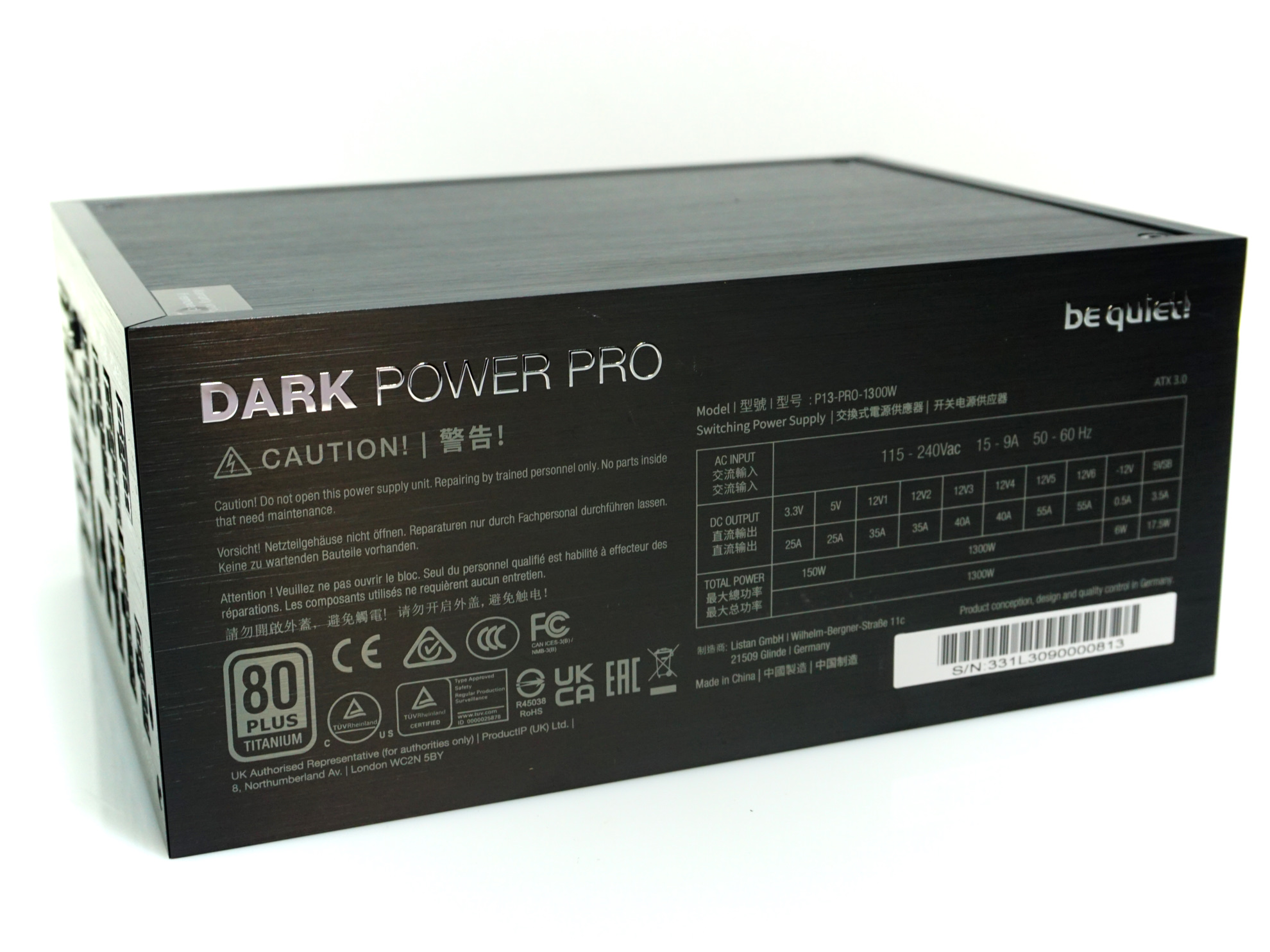
The top side of the chassis is a perfectly clean surface of black brushed aluminum. A large on/off switch can be seen at the rear side of the unit, right below the IEC C19 connector.

The front side of the Dark Power Pro 13 is entirely covered with the connectors for the modular cables. Be Quiet is using a straight 5-pin connector for the SATA/Molex cables, dual row 10-pin cables for the CPU cables, and dual row 12-pin connectors for the PCI Express cables. The ATX cable connects to two connectors at the PSU's side, a large 20-pin connector and a second 8-pin connector. Only the two 12VHPWR connectors are the same as with all ATX 3.0 compliant units we have seen to this date.

The printed legend indicates which virtual 12 V rail corresponds to every connector. For example, each 12VHPWR connector has a “dedicated” 12V rail with a maximum continuous current rating of 55A (660W). This design serves very well as far as safety and reliability are concerned, as the overcurrent protection would kick in much faster in the case of a fault and is far more likely to protect against catastrophic damage. Typical single-rail designs would require the current to climb several times above the connector’s maximum rating and, in case of a critical fault, the equipment will likely be damaged by the high current before the protection kicks in. It is not without its downsides though, as it can limit the overclocking potential of powerful components due to the limited maximum power per connector. Furthermore, users should be careful not to connect the cables randomly but as recommended in the manual, because the default mode of the Dark Power Pro is with multiple 12V OCP rails, meaning that the PSU will shut down if the load is improperly balanced.
Internal Design
Be Quiet is using its own fans to cool its PSUs. For the Dark Power Pro 13, it is using a modified frameless version of the SilentWings 135mm fan. These fans have a fluid-dynamic bearing (FDB) for very low-noise operation and long-term reliability. The maximum speed of the 135 mm fan is 2600 RPM, an extremely high speed for a fan of this size. The company’s engineers optimized the fan and the body of the PSU itself so as to minimize vibrations and optimize airflow. The only discernable downside of this implementation is that, should the fan ever fail, only a replacement part from the manufacturer would be a direct fit.


The multiple 12V configuration hints that the OEM behind the creation of the Dark Power Pro 13, is Channel-Well Technologies, commonly known as CWT. Although there are now very few examples, CWT’s platforms commonly implemented multiple 12V rails in the past. A quick glance at the inside of the Dark Power Pro 13 also reveals that it is not that much different than its predecessor, with the company merely tweaking the platform to achieve ATX 3.0 compliance and adding two 12VHPWR connectors.

Unlike most units, the main’s switch and AC plug receptacle are attached to a vertical PCB that also hosts a few of the filtering stage components, with the rest on the main PCB. The filtering stage is slightly better than average, totaling six Y capacitors, two X capacitors, and two filtering inductors. It leads to a dual input rectifying bridge configuration, with the bridges attached onto the large heatsink that also holds the active components of the APFC circuit. The passive APFC components are three massive capacitors, two 400V/470μF by Nippon Chemi-Con and one 400V/680μF by Nichicon, as well as two large encased filtering inductors.


On the primary side of the main transformers, we find four transistors forming a full-bridge and LLC inversion topology. There are two transformers and two vertical daughterboards hosting the secondary side conversion circuitry but one 12V output is ultimately generated. The multiple 12V lines are, in layman’s terms, virtual, with the protection circuitry monitoring multiple output lanes instead of just the transformer’s output. The 3.3V and 5V lines are being fed via the DC-to-DC conversion circuits found on the vertical PCB near the front of the unit. Be Quiet’s engineers also added several copper shields.


There is a mix of both solid-state and electrolytic capacitors in the Dark Power Pro 13. Nichicon and Nippon Chemi-Con supply the electrolytic capacitors, while FPCAP and United Chemi-Con supply all of the polymer capacitors. Although it is rare to see that many electrolytic capacitors in this tier of a product, all of the suppliers used are amongst the most renowned capacitor manufacturers currently in existence.



Cold Test Results
Cold Test Results (25°C Ambient)
For the testing of PSUs, we are using high precision electronic loads with a maximum power draw of 2,700 Watts, a Rigol DS5042M 40 MHz oscilloscope, an Extech 380803 power analyzer, two high precision UNI-T UT-325 digital thermometers, an Extech HD600 SPL meter, a self-designed hotbox and various other bits and parts.

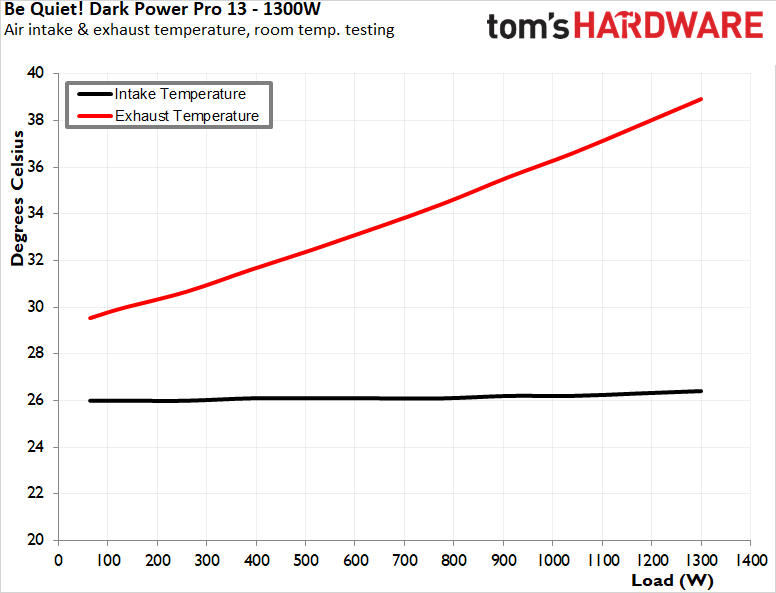

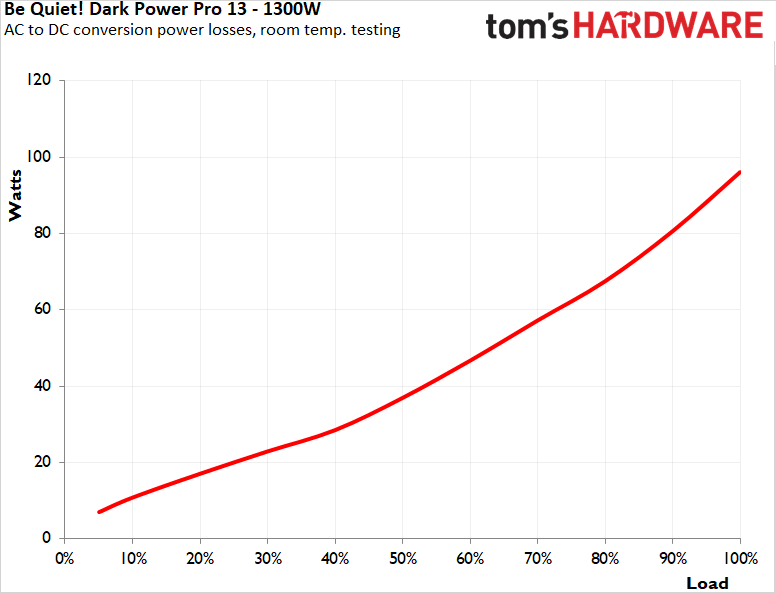

Be Quiet! managed to improve the overall efficiency of the new Dark Power Pro 13 series significantly. Although it does not reach the 80 Plus Titanium certification requirements when the input voltage is 230 VAC, it easily met the certification requirements with an input voltage of 115 VAC (manufacturers commonly target their designs to meet the 80 Plus certification requirements with an input voltage of 115 VAC due to the lower certification thresholds). The average nominal load range (20% to 100% of the unit's capacity) efficiency is 93.7% when powered from a 230 VAC source, which drops down to 93.3% with an input voltage of 115 VAC. The design of the Dark Power Pro 13 also makes it a little more efficient at low loads with a lower input voltage, but the tables turn when the load is greater than 600 Watts.
This PSU does not feature any complex semi-passive thermal design. Instead, Be Quiet opted for a simplistic and reliable temperature/load driven speed controller. The fan does start immediately when the unit is powered on, regardless of the load, but the noise figures while the load is less than 800 Watts are extremely low. Only when the load goes beyond 1,000 Watts will the fan speed up sharply, reaching figures that would be easily audible in a common room.
Hot Test Results
Hot Test Results (~45°C Ambient)
The overall performance of the Dark Power Pro 13 1300W PSU degrades only slightly when the ambient temperature is high, suggesting minimal thermal stress. The drop at heavy loads is also minimal, meaning that the components of the Dark Power Pro 13 handle the high output and the high temperatures without any significant stress. The energy conversion efficiency drops by about 0.5% across the nominal load range with an input voltage of 230 VAC, which drop is marginally smaller with an input voltage of 115 VAC. In both cases, the efficiency drop is almost entirely evenly distributed across the entire load range.

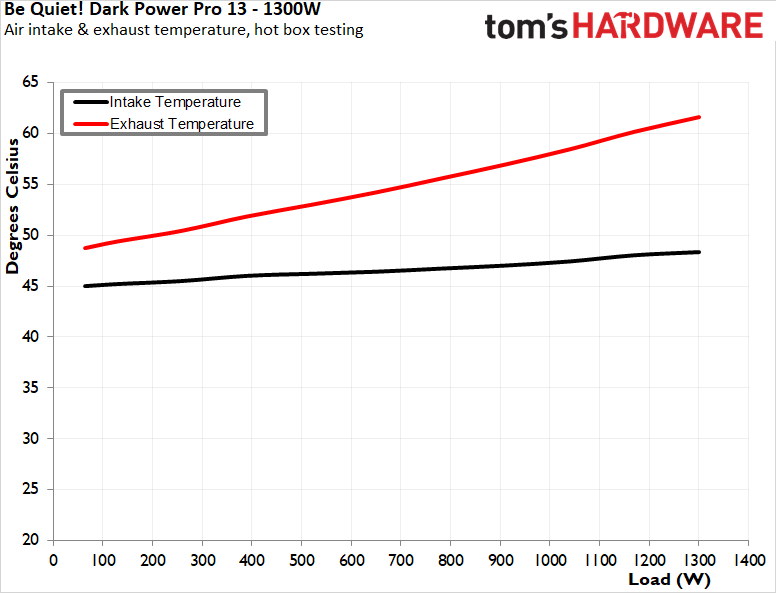

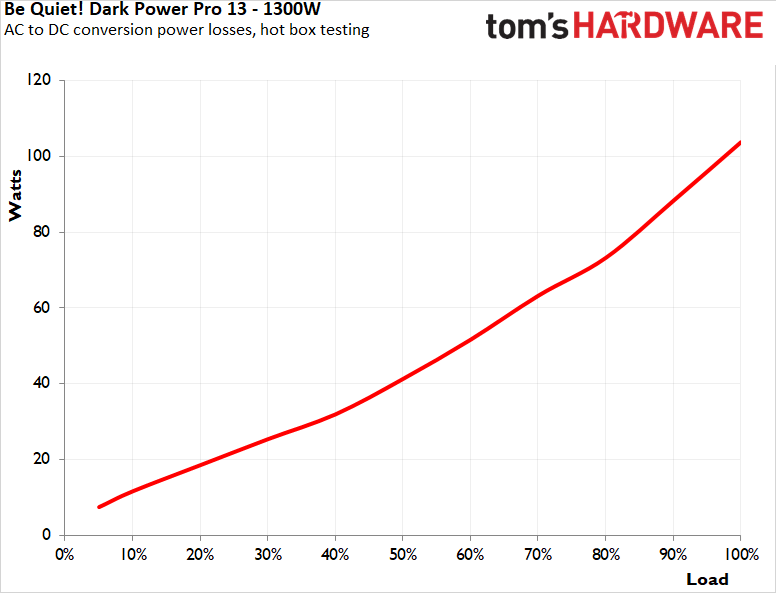

The thermal performance of the Dark Power Pro 13 is mediocre when the ambient temperatures are very high. As the control circuitry is geared toward silent operation, the component temperatures can get high even when the load is low – at least for a unit that has its fan always on. Component temperatures can reach over 100 °C if the PSU is very heavily loaded for prolonged periods of time, yet the PSU keeps coping with the adverse operating conditions and performs seamlessly without any hint of thermal stress.
The Silent Wings fan is valiantly striving to maintain normal operating conditions when the ambient conditions are adverse. It does a fine job while the load is relatively low, managing to maintain tolerable noise levels. The speed of the fan increases alongside with the load, quickly reaching sound pressure levels that would be uncomfortable for typical everyday usage, with the fan reaching its maximum speed when the load is a little over 900 Watts.
PSU Quality and Bottom Line
Power Supply Quality
As part of our testing, we also check output parameters are within specifications, as well as voltage ripple and line noise. Our equipment limits us from testing the Dark Power Pro 13 in its default multi-rail mode, as it requires more electronic loads than we have available. We performed our testing, unless noted otherwise, with the OCK mode enabled.
The electrical performance of the Dark Power Pro 13 does not set any records, but it is great overall. Voltage regulation is impressive on the primary 12V line, with our instruments showing less than 0.6% across the nominal load range. It is not as tight on the secondary 3.3V/5V lines, which both were at about 1.1%, but that remains a good performance figure. The filtering on all voltage lines is very good, with a maximum of 12 mV and 14 mV on the 3.3V and 5V lines respectively, and 24 mV on the 12V line.
As part of our standard testing, we test the primary protections of all PSUs we review (Over Current, Over Voltage, Over Power, and Short Circuit). All of the protections of the Dark Power Pro 13 PSU engaged normally. With the OCK mode on, the OCP is at about 140% of the unit’s rated capacity, kicking in almost instantly at 151A. Testing with the OCK mode disabled gave us abnormal results, with the OCP kicking in randomly anywhere between 120%-160% of a rail’s capacity, most likely because we could technically load only three out of the six 12V rails with our equipment, confusing the OCP detectors. All of the OCP protections are high, but not abnormally so for a top-tier ATX 3.0 compliant PSU.
| Load (Watts) | 262.81 W | Header Cell - Column 2 | 656.19 W | Header Cell - Column 4 | 980.71 W | Header Cell - Column 6 | 1304.43 W | Header Cell - Column 8 |
|---|---|---|---|---|---|---|---|---|
| Load (Percent) | 20.22% | Row 0 - Cell 2 | 50.48% | Row 0 - Cell 4 | 75.44% | Row 0 - Cell 6 | 100.34% | Row 0 - Cell 8 |
| Amperes | Volts | Amperes | Volts | Amperes | Volts | Amperes | Volts | |
| 3.3 V | 2.32 | 3.37 | 5.79 | 3.37 | 8.68 | 3.34 | 11.58 | 3.33 |
| 5 V | 2.32 | 5.06 | 5.79 | 5.05 | 8.68 | 5.02 | 11.58 | 5 |
| 12 V | 20.07 | 12.12 | 50.16 | 12.11 | 75.24 | 12.07 | 100.33 | 12.04 |
| Line | Regulation (20% to 100% load) | Voltage Ripple (mV) | Row 0 - Cell 3 | Row 0 - Cell 4 | Row 0 - Cell 5 | Row 0 - Cell 6 | Row 0 - Cell 7 |
| Row 1 - Cell 0 | Row 1 - Cell 1 | 20% Load | 50% Load | 75% Load | 100% Load | CL1 12V | CL2 3.3V + 5V |
| 3.3V | 1.10% | 10 | 8 | 12 | 14 | 10 | 16 |
| 5V | 1.10% | 10 | 8 | 14 | 16 | 8 | 20 |
| 12V | 0.60% | 12 | 16 | 20 | 24 | 26 | 20 |
Bottom Line
The Dark Power Pro 13 series is Be Quiet’s pinnacle, a product designed with the best possible overall characteristics, relinquishing most (but not all) consideration of cost-effectiveness. The end result is an exceptional power supply unit with a focus on delivering top-notch performance and reliability, yet with a very hefty price tag that is disproportionately higher than mainstream and even premium units.
When it comes to build quality, this PSU is truly exceptional. It boasts a classy external appearance and a very clean layout. The integration of high-quality Japanese electrolytic and solid-state capacitors, along with high-performance active components, ensures stable and efficient power delivery. Channel Well Technologies (CWT) is a highly reputable OEM with a proven track record of producing reliable platforms. And that promise of reliability is underscored by the PSU's 10-year manufacturer’s warranty.

All of the performance figures for the Dark Power Pro 13 are better than what we got from the previous Dark Power Pro version – some only slightly and some notably – so it is good to see the company improving on all fronts, even if by just a little. The power quality of the Dark Power Pro 13 is excellent, with tight voltage regulation and good voltage filtering across all rails. Nevertheless, neither the voltage regulation nor its filtering is truly better than most premium PSU designs. The energy conversion efficiency is where it does stand out, meeting the 80 Plus Titanium certification requirements with a 115V AC input.
Thermal performance is another strong suit of the Dark Power Pro 13. While it exhibits elevated operating temperatures under extreme loads and high ambient temperatures, these levels do not pose any danger or indicate thermal stress. The inclusion of the proprietary Silent Wings frameless 135 mm fan contributes to its ability to maintain low noise levels during normal operating conditions. Even under heavy loads, the PSU remains practically noiseless, ensuring a quiet computing experience.

Overall, the Be Quiet Dark Power Pro 13 is a top-tier option for a PC PSU, meant for users who are willing to pay more than a little extra for top efficiency, quality, and aesthetics. The Dark Power Pro 13 is currently available for $330 in the US, a price tag that is surely going to push all budget-conscious PC builders away. Though regardless of the high price tag, when compared to its direct competition in the flagship PSU space, the Dark Power Pro 13 is still a highly competitive product. Ultimately, for users who are after a true top-tier PSU that will last for years to come – budgets and cost-effectiveness be damned – the Dark Power Pro 13 is a worthwhile investment that will not disappoint.
MORE: Best Power Supplies
MORE: How We Test Power Supplies
MORE: All Power Supply Content

Dr. E. Fylladitakis has been passionate about PCs since the 8088 era, beginning his PC gaming journey with classics like Metal Mutant and Battle Chess. Not long after, he built his first PC, a 486, and has been an enthusiast ever since. In the early 2000’s, he delved deeply into overclocking Duron and Pentium 4 processors, liquid cooling, and phase-change cooling technologies. While he has an extensive and broad engineering education, Dr. Fylladitakis specializes in electrical and energy engineering, with numerous articles published in scientific journals, some contributing to novel cooling technologies and power electronics. He has been a hardware reviewer at AnandTech for nearly a decade. Outside of his professional pursuits, he enjoys immersing himself in a good philosophy book and unwinding through PC games.
-
EzzyB Perhaps you can clear something up for me. I was shopping on Amazon and the 12 series are still available for a very attractive price (my needs are closer to 1000 watts). They do list 12 series supplies with both ATX 3.0 support and without.Reply
Do you have any insight on the other differences between the 12 and 13 series other than ATX 3.0? It's very tempting to save $60-$70 on the 12 series with ATX 3.0 if they are otherwise very similar.
